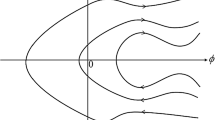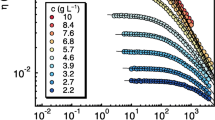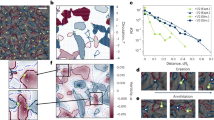Abstract
Employing a mesoscopic Doi tensor model, we develop transient statistical properties of sheared nematic polymer monodomains consistent with typical experimental protocols. Our goal is to convey to the experimentalist a list of expected outcomes, based not only on properties of the nematic liquid and imposed flow rate, but also on the timescale of the experiment and variability in the initial conditions. Step 1 is deterministic: we solve the model equations completely, then compile the flow-phase diagram of all monodomain attractors and phase transitions versus nematic concentration and Peclet number (shear rate normalized by molecular relaxation rate). Step 2 is to overlay on the phase diagram a statistical diagnostic of the expected time, 〈t〉 A , to reach a small neighborhood of every attractor A. The statistics are taken over the arbitrary quiescent director angle on the sphere, modeling experiments that begin from rest. Step 3 is to explore parameter regimes with multiple attractors, where we statistically determine the likelihood of convergence to each attractor. These statistical properties are critical for any application of theoretical models to the interpretation of experimental data. If 〈t〉 A is longer than the timescale of the experiment, attractor A is never fully resonated and the relevant stress and scattering predictions are those of the transients, not the attractor. In bi-stable and tri-stable parameter regimes, which are typical of nematic polymers, a distribution of monodomains of each type will populate the sample, so experimental data must be compared with weighted averages based on the likelihood of each attractor (see Grosso et al (2003) Phys Rev Lett 90:098304). The final step is to give statistics of shear stress and normal stress differences during the approach to each attractor type, as well as typical paths of the major director that are contrasted with the results of Van Horn et al (Rheol Acta (2003) 42(6):585–589) with Leslie-Ericksen theory.


















Similar content being viewed by others
References
Larson RG, Ottinger H (1991) Macromolecules 24:6270–6282
Larson RG (1999) The structure and rheology of complex fluids. Oxford University Press, Oxford, UK
Van Horn BL, Boudreau DM, Winter HH (2003) Rheol Acta 42(6):585–589
Rey AD, Tsuji T (1998) Macromol Theor Simul 7:623–639
Forest MG, Wang Q (2003) Rheol Acta 42:20–46
Faraoni V, Grosso M, Crescitelli S, Maffettone PL (1999) J Rheol 43:829–843
Forest MG, Zhou R, Wang Q (2003) J Rheol 47(1):105–127
Forest MG, Wang Q, Zhou R (2003) Rheol Acta 43(1):17–37
Forest MG, Wang Q, Zhou R (2003) Rheol Acta (submitted)
Grosso M, Keunings R, Crescitelli S, Maffettone PL (2001) Phys Rev Lett 86(14):3184–3187
Beris AN, Edwards BJ (1994) Thermodynamics of flowing systems with internal microstructure. Oxford University Press, Oxford, UK
Rienacker GR, Hess S (1999) Physica A 267:294–321
Forest MG, Wang Q, Zhou R (2002) Phys Rev E 66(3):031712
Fuller GG (1995) Optical rheometry of complex fluids. Oxford University Press, Oxford, UK
Marrucci G, Maffettone PL (1989) Macromolecules 22:4076–4082
Maffettone PL, Grosso M, Friedenberg MC, Fuller GG (1996) Macromolecules 29:8473–8478
Maruyama T, Fuller GG, Grosso M, Maffettone PL (1998) J Non-Newtonian Fluid Mech 76:233–247
Yao L, Zheng X, Forest MG, Wang Q, Zhou R (2004) A model for defect dynamics in sheared nematic polymers. University of North Carolina Program in Applied Mathematics Preprint, Chapel Hill, NC
Doi M (1981) J Polym Sci Pol Phys 19:229–243
Larson RG (1990) Macromolecules 23:3983–3992
Tan ZJ, Berry GC (2003) J Rheol 47:73–104
Van Horn BL, Winter HH (2000) Rheol Acta 39:294–300
Doedel EJ, Champneys AR, Fairgrieve TF, Kuznetsov YA, Sandstede B, Wang X (1997) AUTO97: Continuation and bifurcation software for ordinary differential equations. Concordia University, Montreal, Canada
Rienacker GR, Kroger M, Hess S (2002) Phys Rev E 66:040702
Hess S (2003) Z Naturforsch A 58:377–391
Grosso M, Crescitelli S, Somma E, Vermant J, Moldenaers P, Maffettone PL (2003) Phys Rev Lett 90:098304
Acknowledgements
This work was sponsored by the Air Force Office of Scientific Research, Air Force Materials Command, USAF, under grant no. F49620–02–1-0086, and the National Science Foundation through grants DMI-0115445, DMS-0204243 and DMS-0308019. The work was supported in part by the NASA University Research, Engineering and Technology Institute on Bio Inspired Materials (BIMat), under award no. NCC-1–02037.
Author information
Authors and Affiliations
Corresponding author
Rights and permissions
About this article
Cite this article
Zheng, X., Forest, M.G., Zhou, R. et al. Likelihood and expected-time statistics of monodomain attractors in sheared discotic and rod-like nematic polymers. Rheol Acta 44, 219–234 (2005). https://doi.org/10.1007/s00397-004-0377-4
Received:
Accepted:
Published:
Issue Date:
DOI: https://doi.org/10.1007/s00397-004-0377-4




